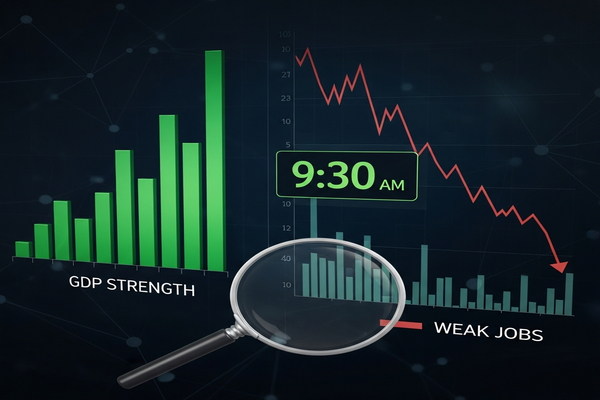
GDP and jobs are on a collision course. U.S. economic output is running hot while payroll gains have slowed to a pace not seen outside recession windows. That mismatch matters now because markets must reconcile fast GDP readings driven by AI investment with weak hiring that could reshape risk appetite in the near term. Globally, the gap affects bond yields, corporate earnings and policy choices in the U.S., Europe and Asia.
Market backdrop: the data that has traders on edge
Markets opened the week with one clear theme. The raw GDP numbers look strong. The job market looks soft. That disagreement is the central risk for today’s trading session.
GDP grew at a 3.8 percent annual rate in Q2 and the Atlanta Fed’s GDPNow model has tracked Q3 at about 3.9 percent. Policymakers and investors point to large capital spending on AI data centers and software as a key driver. Those outlays are raising productivity and lifting headline output.
Meanwhile job growth averaged roughly 27,000 per month from May through August. Historically, that kind of flatline in payroll gains appears only around recessions or recoveries. The unemployment rate has not spiked, however, which leaves room for different readings. Some economists argue that migration policy has reduced labor supply. Others see soft hiring as early signs of cooling demand.
For markets this morning the immediate variables are clear. Equity traders will parse earnings commentary for hiring plans and pricing power. Fixed income desks will watch whether weak payrolls reduce rate hike risk or whether strong GDP keeps yields elevated. Currency and commodity traders will look for cross currents between global growth expectations and safe haven flows.
Signals from corporate America and the consumer
With some official data delayed by a government shutdown, investors are turning to corporate reports for clues about consumer demand. Anecdotes from CEOs are serving as near real time indicators.
General Motors (NYSE:GM) reported better than expected Q3 results driven by pickups and resilient demand. Executives said tariffs would cost up to $4.5 billion this year but that the company expects to offset more than a third of that burden. The message to markets is that companies can absorb some policy shocks while sales remain healthy.
Coca-Cola (NYSE:KO) also signaled robust spending on premium and no-sugar products. The company noted that higher income households are sustaining purchases even as lower income groups trim spending. That pattern matters for stock selection. Consumer staples and premium brands may show more resilience. Mass market retailers and discretionary names may come under greater scrutiny.
These corporate data points will shape sector flow today. Stocks linked to AI and cloud infrastructure may continue to outperform if investors buy the growth story behind GDP. Retailers and leisure names will be tested on margins and sales mix comments contained in earnings calls.
How markets may price Fed risk and the path for yields
Federal Reserve officials have acknowledged the divergence. Fed governor Christopher Waller said the economy shows solid activity while the labor market is soft and that something has to give. In market terms that means traders will balance the risk that GDP cools with the risk that hiring recovers.
Bond markets will be particularly sensitive. If payrolls continue to disappoint, traders may push back on the probability of additional rate hikes and long yields could slip. If GDP prints or corporate signals suggest durable demand, yields could stay elevated. That tug of war will affect bank stocks and interest rate sensitive sectors.
Option markets and volatility desks will likely reflect this uncertainty. Investors should expect price swings around any incoming data or high profile earnings commentary. Currency markets will also react as rate expectations shift between the dollar and major peers in Europe and Asia.
Global and regional implications
The U.S. data mix matters beyond domestic indices. European and Asian investors use U.S. GDP and jobs as inputs for growth forecasts and policy expectations. Strong U.S. GDP can lift commodity demand forecasts and benefit exporters in Asia. At the same time persistent weakness in U.S. hiring could reduce global demand over time and pressure cyclical exporters.
Emerging markets face a double exposure. Higher U.S. growth and yields can pull capital away and tighten financial conditions for local markets. However, robust global demand for AI hardware and cloud services could create pockets of outperformance among technology supply chain companies in Asia.
Central banks in Europe and Asia will watch U.S. labor trends as they calibrate policy. If weak payrolls reduce the growth outlook, policymakers may have space to pause on further tightening. If U.S. GDP remains strong, global rate differentials may continue to move, weighing on emerging market currencies.
Trading session focus and scenario planning
For today’s session traders will monitor three main inputs. First, any fresh payroll or hiring proxies that arrive through private surveys or company comments. Second, earnings calls that flag hiring intentions, pricing power and tariff cost pass through. Third, central bank or policy commentary that either amplifies or soothes market concerns about the split between output and employment.
In a scenario where corporate anecdotes reinforce solid demand and hiring signals brighten, risk appetite should strengthen and cyclical stocks may lead gains. Bond yields could rise and the dollar may firm. In a scenario where hiring stays weak and companies flag consumer weakness among lower income groups, risk assets could underperform and safe haven flows could push yields lower.
Traders should also watch AI related sectors. Large cap technology and cloud infrastructure names are a core reason GDP looks strong. Those stocks may carry the session if investors double down on demand for data center equipment and software.
Finally, keep an eye on tariff related headlines. Firms have reported tariff impacts that change earnings outlooks and supply chain decisions. Any new tariff developments or cost pass through commentary will immediately affect autos, industrials and parts of the manufacturing complex.
Today’s session will be about reconciling strong GDP readings with weak hiring. The market’s job is to decide which signal is nearer the truth. The answer will set tone across equities, bonds, currencies and commodities for the next stretch of trading.












